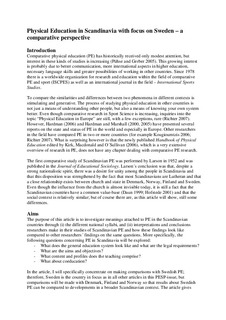| dc.description.abstract | PURPOSE: The purpose of this paper is to investigate meanings attached to physical education in the Scandinavian countries through (1) the different national syllabi; and (2) interpretations and conclusions researchers make in their studies of Scandinavian physical education and how these findings look like compared with other researchers' findings on the same questions. Physical education in Sweden is the focus, but comparisons are made with Denmark, Finland, and Norway. METHOD: This study can be seen as a qualitative textual analysis, and in this case analysis of syllabi as well as research texts produced about physical education in Scandinavia during the last ten years. FINDINGS: The analysis shows that school systems in the Scandinavian countries are very similar. Recent educational reforms have moved towards decentralization and an emphasis on goals. Aims and objectives are formulated in national syllabi, but content and methods are a local responsibility. Sweden took the first step and the three other countries have moved in the same direction. The comparative analysis shows that there are many similarities between physical education in the Scandinavian countries. It even seems possible to talk about a Scandinavian model for physical education, characterized by a broad content area, where pupils choose from a kind of 'smorgasbord' of physical activities. It is through multi-activity programmes of different physical activities that pupils are to learn. In practice, however, it seems as if, just as in the rest of Europe, ball games, gymnastics, fitness training, and track and field dominate the subject. On the other hand, typical activities for Scandinavian culture such as skiing, skating, orienteering, and outdoor education with a focus on environmental questions and health form part of a physical education programme that differs from those found in most other countries. Co-education is a main principle in Sweden, Norway, and Denmark, while in Finland physical education is taught in separate groups. Further, cooperation, socialization, and team effort are emphasized more than physiology, competition, and results. Health is a central proficiency area in physical education in especially Sweden and Finland, while in Denmark and Norway health is not emphasized as much as in the two first mentioned countries. Even though a health perspective should permeate the subject in all the Scandinavian countries, what this means in practice is seldom discussed and the teachers have difficulty in defining the concept. The issue of time allocation is quite complicated in Scandinavia due to localized control of curricular timetables and practices of offering options or electives. Researchers do agree about the conclusion that there has been a time reduction. However, the situation for physical education seems to be better in the Scandinavian countries than in many other countries around the world. In Sweden, for example, the climate vis-a-vis physical education is now much more positive, and the subject has regained status and resources. The situation for physical education in Finland and Norway also looks positive, if not quite as good as in Sweden. Physical education in Denmark, however, still waits for a breakthrough. | en |
